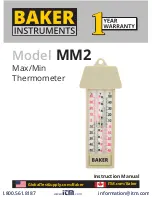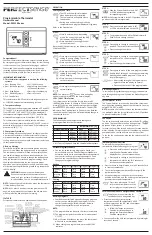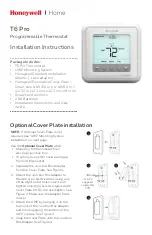
Installation and Connection
The thermostat is provided with three connections for cable lugs;
also observe the label on the bottom of the thermostat.
If in doubt, leave the installation and connection to a specialist.
Operating Principle
There is a liquid in the long capillary tube (and the sensor tip),
which is permanently connected to the thermostat, which ex-
pands on warming. At the end of the capillary tube in the thermostat there is a pressure sensor, which is
mechanically preloaded by the adjustment spindle.
A heating device, which is activated via the switch contact, increases the temperature; the liquid in the
installed sensor warms up and expands.
The control element on the pressure sensor breaks the circuit, when it reaches a given temperature.
The temperature falls again and the liquid in the capillary tube contracts.
At a given temperature, the circuit closes again and the process is repeated.
The temperature at which the thermostat breaks the circuit can be adjusted using the adjustment spindle.
Since this is not an electronic control, it is not possible to set thermostat exactly to a specific temperature.
The switch contact allows control of both cooling and heating, depending on which thermostat
contacts are used to make the connection (C + 2 or C + 1).
Care and Cleaning
• Do not use any aggressive cleaning agents, rubbing alcohol or other chemical solutions as they can
cause damage to the housing and malfunctioning.
•
Clean the product with a dry, fibre-free cloth.
Disposal
Electronic devices are recyclable waste and must not be disposed of in the household waste.
At the end of its service life, dispose of the product in accordance with applicable regulatory
guidelines.
You thus fulfill your statutory obligations and contribute to the protection of the environment.
Technical Data
Contact load .......................................................... 250 V/AC, 50/60 Hz, 20 A
Control range ......................................................... 0 °C to +50 °C
Max. temperature for sensor ................................. 60 °C
Max. temperature for thermostat casing ................ 120 °C
Accuracy ................................................................ ±2 °C
Switching hysteresis (differential) .......................... 2 ±1 °C
Length of capillary tube ......................................... approx. 1 m
Bending radius for capillary tube ........................... min. 5 mm
Operating Instructions
Inbuilt Thermostat (0 to +50 °C)
Item No. 2226738
Intended Use
The thermostat is intended for controlling the temperature (e.g. in connection with radiators or cooling units)
within a temperature range of 0 ºC to +50 ºC. All the safety and installation instructions must be followed
carefully. This product complies with the applicable National and European requirements. All names of com-
panies and products are the trademarks of the respective owner. All rights reserved.
Delivery Content
• Thermostat with capillary sensor
• Operating instructions
Up-to-Date Operating Instructions
Download the latest operating instructions at www.conrad.com/downloads or scan the
QR code shown. Follow the instructions on the website.
Explanation of Symbols
The symbol with the lightning in the triangle is used if there is a risk to your health, e.g. due to an
electric shock.
The symbol with the exclamation mark in the triangle is used to indicate important information in
these operating instructions. Always read this information carefully.
The arrow symbol indicates special information and advice on operation.
Safety Instructions
Read the operating instructions carefully and especially observe the safety information.
If you do not follow the safety instructions and information on proper handling in this
manual, we assume no liability for any resulting personal injury or damage to property.
Such cases will invalidate the warranty/guarantee.
a) General Information
•
The unauthorised conversion and/or modification of the product is not allowed for safety and
approval reasons. Never dismantle the product
• The product must not be exposed to extreme temperatures, strong vibrations or heavy
mechanical stress.
• The product must not get damp or wet, it is solely intended for use in dry, indoor spaces.
• The product is not a toy and should be kept out of the reach of children!
• Do not leave packaging material carelessly lying around since it could become a dangerous
plaything for children.
• In commercial institutions, the accident prevention regulations of the employer’s liability insur-
ance association for electrical systems and operating facilities are to be observed!
b) Installation
•
The product may only be installed by a qualified technician (e.g. electrician) who is
familiar with the relevant regulations (e.g. VDE, German electrical wiring regulations)!
Improper work, carried out on the mains voltage, endangers not only your own life but
also the life of others!
If you do not have the expertise required for the installation, do not install it yourself
but ask a qualified technician.
• The thermostat may only be installed and operated in enclosed housings. Only the spindle for
the rotary knob may lead to the outside. The enclosed rotary knob (or another suitable rotary
knob) must be mounted on the spindle.
•
The specified safety distance between live components carrying mains voltage (contacts or
connections on the thermostat, etc.) and exposed parts of the enclosure (the device in which
the thermostat is installed) must be maintained at all times.
• The device in which the thermostat is to be installed must be disconnected from the mains
voltage and all other cables/leads. Disconnect the mains plug from the mains socket.
If the device does not have a mains plug but is permanently connected to the mains voltage,
switch off the corresponding circuit breakers and also at the residual current circuit breaker, so
the mains supply line is disconnected on all poles from the mains voltage.
Secure it against unauthorised reconnection, e.g., with a danger sign.
Check there is no voltage with a suitable measuring instrument (e.g. a digital multimeter).
• Capacitors in the device in which the thermostat is to be installed may remain charged for
a long time, even after the device is switched off and disconnected from the mains voltage.
• There is a risk of a life-threatening electric shock!
• Do not use the thermostat in rooms or under adverse ambient conditions where combustible
gases, vapours or dust are or may be present! There is a risk of explosion!
• The input power of the thermostat (see “Technical Data”) must not be exceeded.
• When routing the capillary tube and also when attaching the sensor, make sure that neither
the capillary tube nor the sensor is kinked, pinched or otherwise damaged.
Do not shorten or cut off the capillary tube or the sensor.
Do not screw any screws or anything similar through the sensor tip.
Doing so renders the thermostat unusable!
This is a publication by Conrad Electronic SE, Klaus-Conrad-Str. 1, D-92240 Hirschau (www.conrad.com). All rights in-
cluding translation reserved. Reproduction by any method, e.g. photocopy, microfilming, or the capture in electronic data
processing systems require the prior written approval by the editor. Reprinting, also in part, is prohibited. This publication
represent the technical status at the time of printing.
Copyright 2020 by Conrad Electronic SE.
*2226738_v1_0120_02_dh_m_en






















